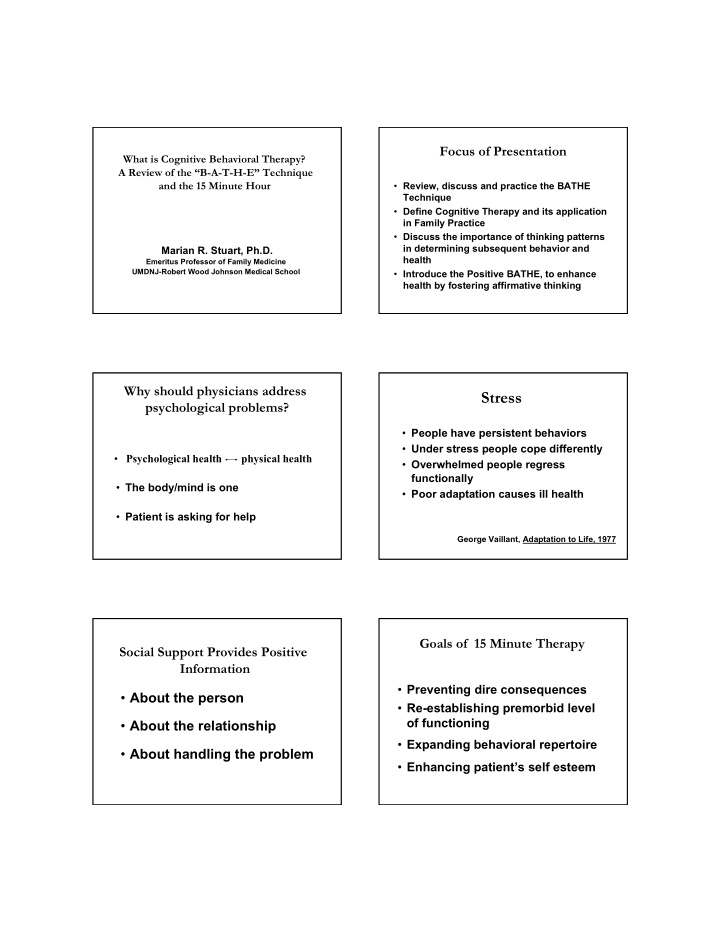



Focus of Presentation What is Cognitive Behavioral Therapy? A Review of the “B-A-T-H-E” Technique and the 15 Minute Hour • Review, discuss and practice the BATHE Technique • Define Cognitive Therapy and its application in Family Practice • Discuss the importance of thinking patterns in determining subsequent behavior and Marian R. Stuart, Ph.D. health Emeritus Professor of Family Medicine UMDNJ-Robert Wood Johnson Medical School • Introduce the Positive BATHE, to enhance health by fostering affirmative thinking Why should physicians address Stress psychological problems? • People have persistent behaviors • Under stress people cope differently • Psychological health physical health • Overwhelmed people regress functionally • The body/mind is one • Poor adaptation causes ill health • Patient is asking for help George Vaillant, Adaptation to Life, 1977 Goals of 15 Minute Therapy Social Support Provides Positive Information • Preventing dire consequences • About the person • Re-establishing premorbid level of functioning • About the relationship • Expanding behavioral repertoire • About handling the problem • Enhancing patient’s self esteem
How to BATHE your Patients as you SOAP Them: The BATHE Technique Background: What is going on in your Background life? Affect/Feeling Affect: How does that make you feel? Trouble Trouble: What about it troubles you Handling most? Empathy Handling: How are you handling that? Empathy: That must be very difficult. More Basics Basics of CBT Therapy 5. CBT uses the Socratic method 1. CBT is based on the cognitive model 6. CBT is structured and directive of emotional response 7. CBT is based on an educational model 2. CBT Is brief and time-limited 8. CBT theory and techniques rely on (Elements can be included into a 15 rational thinking minute visit) 9. Homework is a central feature of CBT. 3. A therapeutic relationship is required 4. It’s a collaborative effort Cognitive-Behavioral Therapy Understanding the Impact of Our (CBT) Demystified Stories • Our stories reflect our view of who • We constantly tell ourselves, as we are well as others, stories • Our stories determine what we think • These stories create our reality we are capable of doing and affect our experience • Our stories determine how much effort we will make to change
Challenging Absolutes Cognitive Therapy Edits the Story • Always • First: The story must be heard • Never • Second: The story must be reflected • Everyone back with empathy • No-one • Third: Limits must be challenged Challenging Imposed Limits The Amazing Power of the Word “YET” • Can’t • YET implies it is possible • Must • YET implies impending change • Should • It’s • YET empowers people to contemplate changes impossible Y E T Expected Outcome Y OU • When the patient uses the word YET the story is being edited E MPOWER • The patient is in the contemplative stage T HEM • Behavioral change will follow
Strategies for Helping Patients Four Options for a Bad Situation • Focusing on options • Looking at consequences • Leave it • Applying tincture of time • Change it • Choosing not to choose • Accept it • Reframe it Positive Psychology: The Science of Happiness Three-Step Problem Solving for Bad Situations There is a substantial cognitive component to happiness 1. What is the patient feeling? “It is not just who we are that matters, 2. What does the patient want? but how we think about our lives” 3. What can the patient do about MEP Seligman it? Handbook of Positive Psychology Core Foci of Positive Psychology Confirmatory Research • Understand who we are and how we cope with adversity • Recent studies highlight the striking effects of positive thoughts • Study populations to understand what makes some people more resilient than others • They enhance the ability of the immune system to • Recognize that optimism and other resilient protect the body thoughts and behaviors are learned • They help overcome depression behaviors • They promote both physical and mental health • Teach resilience and help individuals tap into their already existing core strengths and (Psychological Bull 2005:131(6)925-971) virtues • Study and promote happiness despite circumstances
The Positive Bathe Positive vs. Negative Thoughts • B: Best What’s the best thing that’s happened to you this • Positive thoughts or attitudes release week? Or since I saw you? endorphins and have a tonic effect on • A: Affect or Account: How did that make you feel? Or organs How to you account for that? • T: Thankfulness: For what are you most grateful? • Negative thoughts are adverse stimuli that • H : Happen : How can you make things like that happen more frequently? release adrenaline and cause weakness • E: Empathy or Empowerment : That sounds fantastic. I and enervation of specific organs believe that you can do that. Benefits of Accenting the Positive To Bathe or Positive Bathe That is the Question • Studies overwhelmingly connect life satisfaction with • With a new patient or new complaint use the standard increased health and longevity BATHE • Physicians’ ability to promote positive affect in their • When you haven’t seen a patient for several months, use the standard BATHE patients becomes an important skill • In follow up visits try using the Positive BATHE • The Positive BATHE can also be used among by physicians and staff to overcome negativity related to • With routine visits for chronic conditions use the circumstances that can’t be changed Positive BATHE on a regular basis to focus patients on the good things in their lives Summary The 2008 Edition of the Text • The BATHE Technique can be used to efficiently obtain relevant psychosocial data while improving patient satisfaction • Simple cognitive interventions can help patients to feel competent and connected while enhancing the therapeutic process Now available as a kindle • Empirical evidence supports the benefit of www.marianstuart.com focusing on the positive aspects of life www.15minutehour.com • The Positive BATHE may enhance patient health by fostering affirmative thinking
Recommend
More recommend